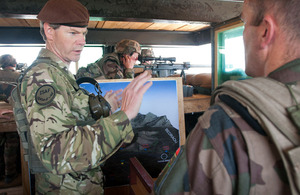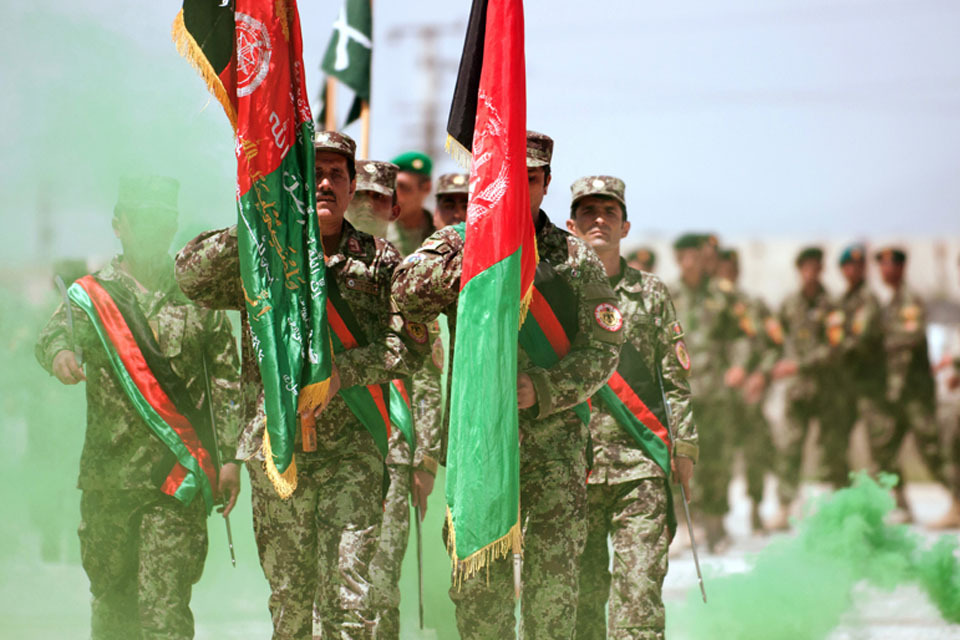British general reports on Afghanistan progress
Lieutenant General Adrian Bradshaw, having recently completed his 12-month tour in Kabul as the Deputy Commander ISAF and UK National Component Commander, gave a briefing to media in the MOD's Main Building yesterday, 17 October.

Lieutenant General Adrian Bradshaw talks about security in Tagab Valley with a French Army serviceman, in a guard tower at Forward Operating Base Tagab, Afghanistan (library image) [Picture: Maitre Christian Valverde, French Navy/ISAF]
The General began by saying that it might come as a surprise, given that some of the media commentary on the Afghan campaign had not been one of unmitigated success, that his message was essentially one of good news.
He said that ISAF was stepping back from the combat role that it had had in the early days and was increasingly mentoring and advising the Afghan National Security Forces (ANSF) who were successfully taking over that responsibility. As a result of disengaging from the combat role, ISAF was suffering between 38 and 40 per cent fewer casualties when compared to last year’s figures.
Around three-quarters of the Afghan population now lived in areas of transition where the ANSF were taking the lead in providing security.
The insurgent threat
Over the years the insurgents’ objective has been to achieve dominance in the populated areas of Helmand and Kandahar provinces. Last year they campaigned strenuously to recover and get control of the districts that had been ceded to the Afghan Government:
In trying to do that the insurgents manifestly failed, and in fact they saw reverses in their fortunes” said the General. “Instead we saw the influence of the government and of the ANSF extended over the year up to Kajaki, and security was established in places like Marjah, which you may remember was once described as ‘the bleeding ulcer of Helmand’.
I walked down there a number of months ago with US and Afghan forces without body armour, without helmet, I went into an internet cafe, talked to members of the local Afghan police and the place was very changed from the picture 12 months ago.
Across the country there has been a nine per cent decrease in enemy attacks, a steady downward trend that has continued throughout 2012.
This trend could be seen in an even more favourable light said General Bradshaw as they had been coloured by the fact that there had been a number of significant operations into insurgent sanctuaries in northern Helmand and elsewhere which prompted quite a lot of response from the insurgents in terms of direct fire attack:
One of the effects that we have seen this year which is quite marked is the displacement of violence out of the main populated areas and out to the margins,” he said.
In the second quarter of 2012 compared to the same period of last year statistics show a 30 per cent reduction in the number of Afghans living within one kilometre of an enemy-initiated attack, and in the third quarter the figure had gone down to 13 per cent:
We are seeing the effects of this on the population in our survey data,” said the General. “The level of concern about security has dropped in relation to other concerns such as employment, provision of electricity and missing bridges - which is a good sign.
All of the signs showed that the insurgents were under pressure. Thanks to a poor poppy harvest and vigorous counter-narcotics activities, such as eradication programmes, seizures of caches and very effective interdiction operations, the insurgents’ traditional revenue had been hit and they had made very little money from narcotics last year.
As a result the insurgents are short of equipment. Partly because of this, improvised explosive device (IED) attacks are ten per cent down across the country compared to last year’s numbers.
An indicative example being the increasing cost of making IEDs:
Last year an IED would cost on average $200 [US dollars] to make, whereas now they are costing between $600 and $800.
The insurgents’ response to this is grim and points to desperation:
In Sangin, insurgents are targeting people whose family members have accidentally triggered IEDs, usually with dire consequences, forcing them to publicly apologise; they then flog them and recover the cost of the IED from them.
There has been a 15 per cent reduction in explosions across the country since last year which points to an improvement in the find and clear procedures. And in the last three years the number of IED attacks resulting in deaths of ISAF troops has reduced from 25 to 12 per cent:
We continue to bear down on the use of IEDs; of course they remain a significant threat, and it is never time to get complacent about it,” said the General.
Insurgents lose heart
General Bradshaw went on to describe the effect that all this was having on the Taliban’s leadership which was showing ever-widening fractures. He referred to an unclassified open source report by a senior Taliban leader published in a newspaper. The context was surprisingly downbeat, free from the usual insurgent rhetoric:
The Taliban capturing Kabul,” one paragraph began, “is a very distant prospect.
This tells us that they are beginning to realise that they cannot achieve their aims by military means alone. That means they know they have to choose the political path,” explained the General, who also pointed out that the text made no reference to 2014 or the possibility that things might improve for the insurgents after that.
Reintegration
As it seemed that the message was beginning to seep into the insurgent’s mind that it was time to engage with the legitimate political process, reconciliation and reintegration were gaining momentum to bring the low-level fighters back into the communities:
There is a very effective bureaucracy across the country to allow this to happen, and we have already 5,000 folk in the programme with several hundred more in waiting,” said Lt Gen Bradshaw. “The beneficiaries of this are the communities, and the elders vouch for those in the programme.
He acknowledged that although this was not yet a game-changer, it was significant.

An Afghan National Army honour guard leads a parade formation of newly-graduated non-commisioned officers during a ceremony at Camp Ghazi, Kabul, Afghanistan (library image) [Picture: Warrant Officer Frantisek Stein, Army of the Czech Republic/ISAF]
Afghan National Security Forces
The ANSF had surprised many with the level of progress they had made, said the General. Now a third-of-a-million-strong, three-quarters of the Afghan National Army who were being partnered by ISAF were now in the top three categories of proficiency and improving all the time:
The ANSF are doing between 85 to 95 per cent of all their own training, Afghan instructors are training their own soldiers, with us advising, but more and more standing back.
Their forces in the field have for some time been doing the planning for their operations, and leading in the field, executing very competently at brigade-level, which the General described as ‘operations of some sophistication’.
Where the terrain allowed, such as in Regional Command (East), the ANSF were also leading operations at Corps-level, with brigades manoeuvring in the field:
There’s a bit of tough love in our support, if our advisers see a kandak is running short of water, then they will ask the commanders what they intend to do, but you won’t see lots of ISAF water for the troops to drink. A few days going thirsty drives home the lesson,” said General Bradshaw.
As a consequence, logistics, which had been a weak link, was now being solved. The process for getting supplies was better understood and being factored into the planning.
The strength of the ANSF artillery and special forces had proved themselves and even close air support was developing nicely, as was the Afghan casualty evacuation capability. All in all, this progress, said General Bradshaw, was instilling confidence not only in the ANSF but in the communities that they serve.
Insider threat
The General stressed that the insider threat, known as ‘green on blue’ incidents, was being taken extremely seriously at the very highest level:
Any family who loses a family member to combat operations has our deepest condolences. If they lose a family member to an insider attack, clearly this can be even tougher to deal with and understand,” said the General.
He said that Commander ISAF was dealing with this personally and was determined to grip this issue, and that the Afghan President, Hamid Karzai, was also taking the problem seriously.
General Bradshaw went on to say that the Afghan Army was now a very professional organisation with good systems within it, geared up to spotting and dealing with soldiers who looked as if they were becoming disenchanted, or whose behaviour was causing concern.
The General was also keen to stress that ISAF and Afghan security forces had many thousands of interactions every day of the week:
Every day we see their professionalism and their commitment, and we also see the very effective and close working relationship that we have with them.
Still much to do
General Bradshaw acknowledged that there was still a lot to do but pointed out that there was still two years of development time and he was robust in his view that improvements, partly inspired by the tough love of the ISAF advisers, would be sufficient. The ISAF model, to carefully draw back in graduated stages as the various levels of ANSF capability and confidence grew, was proving to be effective:
There will be no sudden cliff-edge draw back, it will all be carefully managed and modulated, and at the end we are confident the Afghans will be well able to take over the job,” said the General.
He said that it was impressive to see how the locals viewed their security forces and clearly took pride in having their sons and brothers looking after their security.
Lt Gen Bradshaw concluded by paying tribute to UK and ISAF troops and the achievements they were making thanks to their skill, patience, courage and great endurance.